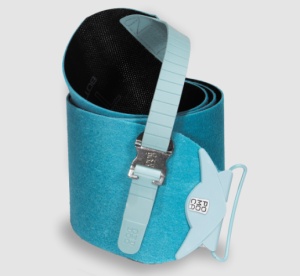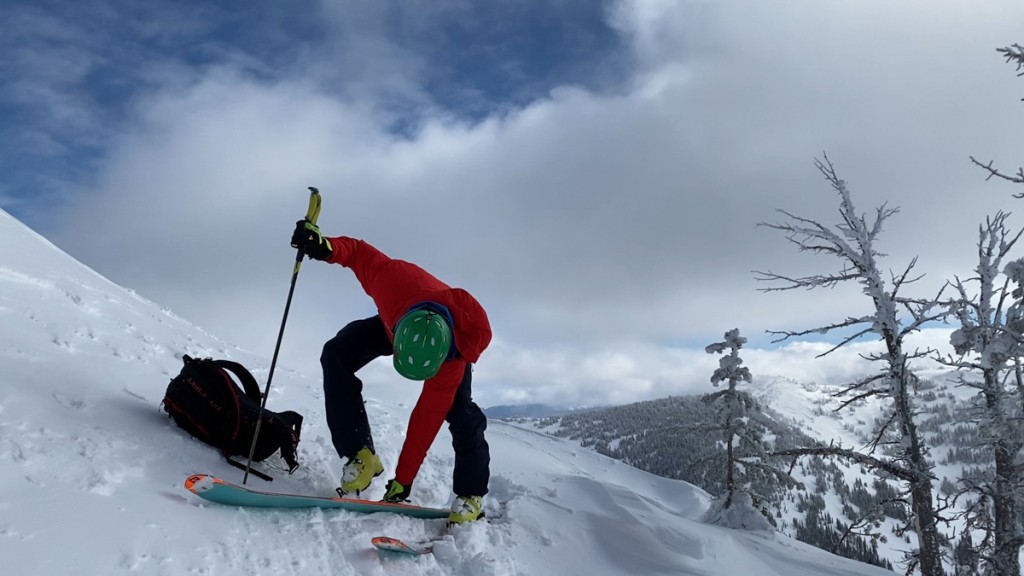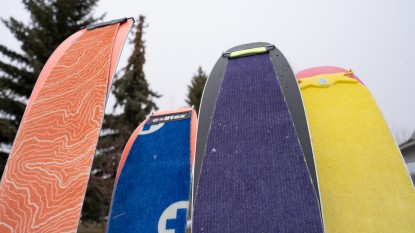Our Verdict
Compare to Similar Products
 This Product
Pomoca Climb Pro S Glide | |||||
|---|---|---|---|---|---|
| Awards | Best Climbing Skin with Traditional Glue | Best Climbing Skin with Cleanable Glue | Best Bang for the Buck | Top Pick for High Speed Performance | |
| Price | $210 List $209.95 at Amazon | $200 List $199.95 at Evo | $201.75 at Amazon | $188.95 at Amazon Compare at 2 sellers | $230 List $229.95 at Amazon |
Overall Score  |
|||||
| Star Rating | |||||
| Bottom Line | Climbing skins inherently strike compromises; winner of our top award, it balances competing demands better than any other | All skin performance is balanced; given our experience with skiing and with reviewing, we find this skin strikes an ideal balance of a variety of factors | We want to continue testing to gain confidence in the longevity of the adhesive, but our testers liked almost everything about these well-balanced skins | Every backcountry skier can use these, especially those that are cost sensitive | For skilled skinners and efficiency hounds on cold snow there are no better skins available |
| Rating Categories | Pomoca Climb Pro S... | Contour Hybrid Mix | Montana Montamix Ad... | Pomoca Climb 2.0 | Pomoca Free Pro 2.0 |
| Glide (30%) | |||||
| Portability (20%) | |||||
| Glue Integrity (20%) | |||||
| Grip (15%) | |||||
| Icing and Glopping Resistance (10%) | |||||
| Compatibility (5%) | |||||
| Specs | Pomoca Climb Pro S... | Contour Hybrid Mix | Montana Montamix Ad... | Pomoca Climb 2.0 | Pomoca Free Pro 2.0 |
| Measured Weight (lbs per pair) | 1.03 | 1.21 | 1.13 | 0.99 | 0.93 |
| Material | 70% Mohair, 30% Nylon | 70% Mohair, 30% Nylon | 65% Mohair, 35%Nylon | 70% Mohair, 30% Nylon | 70% Mohair, 30% Nylon |
| Weight per Pair (Based on Ski Tested) | 468 g for Atomic Backland 95 177 cm | 551 g for Blizzard Zero G 95, 180 cm | 512 g for K2 Wayback 106 179 cm | 448 g for Dynastar M99 Tour, 178 cm | 423 g for DPS Pagoda Tour CFL 105 180 cm |
| Weight per Ski Width (grams/mm) | 2.46 | 2.65 | 2.42 | 2.25 | 2.02 |
| Glue | Traditional | Hybrid Glue | Fusiontec Adhesive | Traditional | Traditional |
| Tip Attachment | Rigid tip loop | Rigid tip loop | Rigid tip loop | Rigid tip loop | Rigid tip loop |
| Tail Attachment | Rubber strap and cam hook | Vinyl strap and cam hook | Vinyl strap and cam hook | Rubber strap and cam hook | Rubber strap and cam hook |
| Ski Compatibility | Universal | Universal | Universal | Universal | Universal |
Our Analysis and Test Results
Product Update — November 2024
Going into the 2024-2025 season, Pomoca is beginning to phase out the Climb Pro S Glide in favor of the new Tour Pro. The Tour Pro skins, most notably, include a new tip and tail clip, as well as Pomoca's newest Ever Dry 3.0 treatment (which is PFC-free). We will continue to link to the Climb Pro S-Glide as long as it remains readily available.
Pomoca's Climb Pro S Glide skins are the best we know of. We aren't alone in really liking them; the web is full of enthusiastic supporters. Our women's backcountry ski lead tester chose this model to equip her tester skis with. Every attribute of climbing skin performance is balanced by an essentially competing attribute in the same product. Optimize for one thing, and another suffers, to at least some degree. With these skins, for all-around, human-powered backcountry skiing, Pomoca nails the balance in every way. They aren't the best in any one category, but they beat the competition overall. They share our top award with another excellent product.
Performance Comparison
Glide
With skins, glide isn't just what you do on short downhills. Ergonomically efficient skin technique slides the ski forward with every step. High friction in this direction sucks energy, in a big way. Yes, the whole point of skins is to grip against backwards sliding. But the real efficiency difference between models is in their forward glide. Full mohair skimo race skins glide the best but might last just a couple races. Full mohair “all-around” skins don't glide quite as well but are at least a little more robust. Blended skins combine mohair and nylon to increase durability, grip, and water resistance.
The Climb Pro S Glide is a blended skin, with all the advantages of that construction, but they glide as well as, or better than, the 100% mohair “all around” skins from other manufacturers.
Portability
Portability — a function of weight and packability — depends on the thickness and stiffness of the material and of the nature and bulk of the tip and tail fastening methods. The tip and tail kit of the Pomoca is pretty low profile. Similarly, the fabric is rigid enough to resist peeling, but flexible enough to fold back on itself with minimal bulk. Quad-folded Climb Pro S Glide skins will fit inside your jacket without dramatically harming your photographed profile.
We test skins on a variety of skis. Each model of skins we test is cut for a certain ski shape and size. We can use each of our skins on a few tester skis, but not all the skins are exactly the same size. This makes direct weight and bulk comparisons difficult. This is a limitation we have come to accept, but must acknowledge that it affects our reviews. We can say on good authority that the Pomoca Climb Pro S Glide, in a given size and profile, is not the most compact or light but is in the top echelon.
Glue Integrity
Pomoca's glue is legendary. We've liked this glue formulation for a long time. Like every other characteristic of climbing skins, the glue requires a balance. When in use, you want maximum stick. During transitions, you want minimal stick. You can't max out them both; you have to pick some sort of middle ground.
How skins stick to your skis is informed by the glue itself and by the rigidity and shape of the material at the tip of your ski. If it can roll, and/or is shaped to catch snow, that snow can “creep” between ski and skin Rigid skins better resist snow creep, but are bulkier in your pack (see what we mean? Every single criterion is a compromise…) As is the theme, the Pomoca fabric is the right stiffness. Snow creep isn't impossible, but it is minimal.
The glue lets go from itself and from your ski base with the right amounts of force. You can readily rip these from your ski with the ski still on your foot, and you can pull them glue from glue without the deltoids of an NBA player.
Grip
Grip is why you need skins. You need them in order to turn your slippery ski bases into traction machines. It is logical but downright wrong to conclude that if gripping is the whole point of skins, you might as well maximize it. You don't need maximum grip. You need enough grip. The Climb Pro S Glide skins have just enough traction.
Yes, other skins have more traction. Yes, in some circumstances, you might find that the Pomoca doesn't have enough grip. Those circumstances, though, usually involve poor technique or a track that is steeper than your body mechanics are optimized for. For your muscles and skeleton, there is an optimal skin track angle, and it isn't “as steep as my skins will grip”. On that optimal skin track angle, the Climb Pro S Glide grabs any conditions you could encounter.
Icing and Glopping Resistance
When you skin through warm, moistened snow, your skins risk getting wet. When wet skins encounter cold, fine-grained, usually fresh snow, you form a vicious amalgam of snow, ice, water, and fabric. That mess can accumulate even more snow and ice, negating any and all gear weight savings and all glide characteristics of your skins. Iced up skins are unusable.
Icing like this is managed by technique (slide them skis forward!), terrain, and timing (avoid sun to shade transitions when that sun is “softening” the snow surface. Especially after a fresh coat of snow), and some gear characteristics. Skins can be treated with a water-resistant coating. The Pomoca has this, but it wears off in all cases. Skin plush material matters a little bit. Nylon absorbs less water than mohair; this is one of a few reasons why blended skins include nylon. Finally, you will almost certainly need to wax your skins at some point in a career or season.
There is less variation between skins and icing characteristics than any of the other attributes we test for. The best aren't that much better than the worst. That being said, the Pomoca is among the best. Especially when new, we had few to no problems with the Climb Pro S Glide. When the coating wears off, you need to wax a little more diligently.
Compatibility
Compatibility is mainly a function of how the skin model is sold and its tip and tail attachment. Some skins are sold only for use with specific ski models. The Climb Pro S Glide is not this sort of product. We call them “universal”. You buy for approximate width and length and then cut for longitudinal shape. Pomoca offers a range of sizes, in this model, that covers every conceivable mass-marketed backcountry ski size and shape.
Other compatibility concerns include tip and tail kit. The rigid tip loop of the Pomoca is pretty good, holding on even the broadest and roundest tips. The tail kit is mostly excellent. A stretchy, notched rubber strap holds a simple, plastic cam lock hook. The hook stays in place between uses so you don't need to reposition it at every application. However, the hook is a bit narrow for most ski tails. It can be forced on, or stretched open before mounting. If stretched open at the beginning of a touring day it mostly stays wide enough for subsequent transitions that day, but it will then slowly shrink back and need to be stretched again.
Should You Buy the Pomoca Climb Pro S Glide?
It was easy to grant these our top award. Despite the quirky and isolated offset glide characteristics, we love these skins. The best endorsement we can give them is that our discerning and dialed women's backcountry ski gear tester chose this exact model to equip her tester skis. But these European skins aren't inexpensive. As you might expect from a top performing product, you will pay a premium.
What Other Climbing Skins Should You Consider?
Although the Climb Pro S Glide skins are expensive, the funny thing about this gear is that the difference in price point between the most expensive and most affordable pairs is almost splitting hairs — skins are just so similar in terms of materials, which make up the bulk of the cost. But for discerning skiers shopping on a tight budget, the Pomoca Climb 2.0 perform very similarly to the Climb Pro S and cost a bit less. The Contour Hybrid Mix skins perform, in every way, as well as this Pomoca flagship model. The main difference is a cleanable glue that requires short, regular maintenance but tends to have a longer lifetime.

















